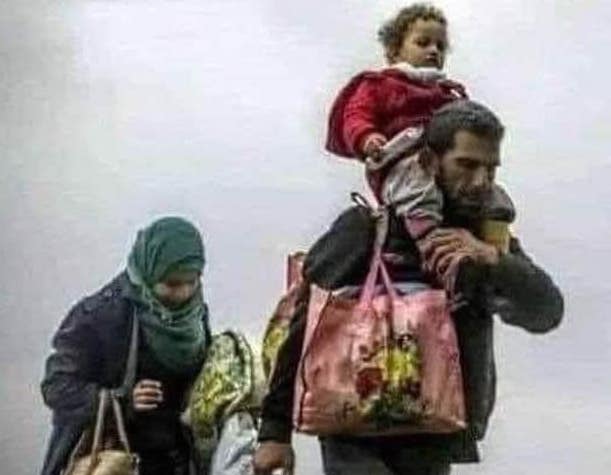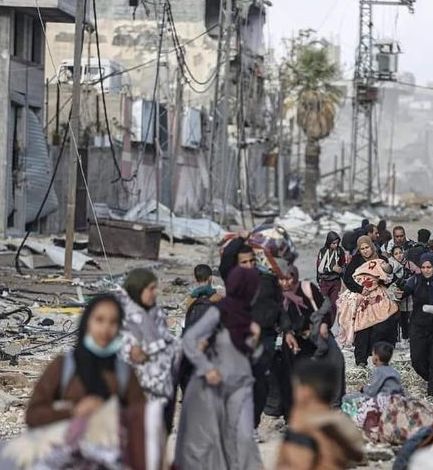
by B Nimri Aziz April 21, 2025. Carried by Counterpunch
“Put Your Soul on Your Hand and Walk” is the title of a soon-to-be-released film featuring photojournalist Fatima Hassouna, the most recent of more than 208 assassinated Gazan journalists.
With no prior knowledge of that film’s content, I knew it emanated from Palestine. These eight words embodied reiterations of a portrait that for many months incessantly haunts me, a photo that had become too routine, and to most of the world, a fleeting image. Even the few who catch glimpses of those slowing moving tributaries of walkers with no destination turn silent.
The Gazans walk on, steadily, seemingly willingly. Away from everything they loved and what each of them is – a soul, a sentient being, a history. They walk on obediently, now perhaps less by fear than from habit and dissolution. They walk without a terminus.

Most refugees worldwide have some geographic objective, however murky, unrealistic and adaptable. Not Gaza’s Palestinians. They are simply vacating a place that they have been warned is unsafe. Their objective is simply to get out of the paths of cordons of ‘predators’ stalking them from all directions, including the sky. If not to save themselves, they are compelled to help their elders, their sick and their children.
The number of displaced people and refugees today is of a staggering magnitude never recorded in any era of world history. Most often war and military occupation is the motive for their uprooting. Or famine, or economic sanctions stemming from conflict. From all across Europe to the Americas; from Tibet to India; from Uganda to the U.K.; from Vietnam in all directions; from Africa northwards through destroyed Libya; from Afghanistan east into Pakistan or westwards anywhere; from Myanmar to Bangladesh; from Iraq and Syria to the Gulf States, Iran and Turkey; from Rwanda to Congo or Congo to Uganda and Tanzania; from Hong Kong and Taiwan to Australia; from Bhutan to Nepal; from Cuba and Venezuela, mostly forced into penury by U.S. sanctions.
They sleep on the road and huddle with strangers in camps. They thrash around capsized boats, hide in city or forest, then set off to reach a temporary safe haven where they might file papers to secure asylum somewhere along a route through several nations. Resourcefully, they gather fragments about the safest crossing point, the most trustworthy smugglers, where temporary succor might be found.

They wade across rivers, ducking predators – human and animal. They make their way towards what they believe beats where they once had a home and a job and a schoolteacher. They move determinedly. Even when turned back, they resolve to try again. Forget those who perished along the way; hold onto stories of those happily settled, somewhere, even temporarily.
Harrowing accounts fill novels and U.N. reports. Yet nothing quite equals the experience of Gaza’s people on the move today. Occasionally a photo emerges of their aimless marches. Children drag bundles of belongings. A crippled youth is pushed along in his wheelchair; an elderly man hangs onto the back of his son, grandson or a paid helper; a heavily shrouded woman is secured to a bicycle maneuvered by a boy. A donkey cart with heavy wheels is invisible under a tower of mattresses. Pots and yellow plastic cans are roped to a teetering load. No other furniture. Walling in these irregular columns of walkers and carts are looming heaps of ghostly, gray collapsed buildings. In the few photos that somehow reach us, I see no stations along the route offering water, no health posts to treat the wounded and exhausted. I wonder: did Israeli bulldozers widen these corridors to nowhere in order to accommodate the exodus?

Isn’t this a death march? Isn’t it a mud plank to the rim of a pit, to be disposed of, in one way or another? Edicts arrive from Israel by drone, by barking soldiers, or by flyers fluttering across bombed homes and hospitals. They direct the newly homeless and wounded to join those earlier displaced: head south, or north, or sideways… to ‘safe zones’. The walkers settle in tents, empty schools, the bombed university – any structure where they can drape a sheet and make a campfire. Bombs shred them there too. Another order arrives: move yet again. To where hardly matters. ‘There’– a closed military zone. ‘Here’– tanks approach, churning furrows behind the walkers, plowing through cemeteries not distinguishing between newly buried and early generations of Palestinians.
At one point– maybe it was following the broken ceasefire agreement– those displaced from North Gaza learned they could go back to neighborhoods transformed into heaps of rubble. Still, they stood, and reloaded what they could manage. They set out to locate a familiar corner and if lucky, retrieve the bones of lost ones under those blocks of cement.

A few of us, those able to follow some of Israel’s duplicity and crimes, witnessed that endless, quiet line of families trudging northwards – the placid Mediterranean coast to the west, miles of barren bleakness on their eastern flank. Some walkers may have felt hopeful even under those spare conditions. Their goal was reclaiming their minute piece of Palestine, whatever its condition. But that expectation was shattered and they set out walking once again. Their faces are a void, as is their condition. No use complaining; no use crying out for help.
Some tell of being displaced eight times. Each time they carry less. Their numbers dwindle as more perish. Some simply refuse to abandon the rubble they have reoccupied, leaving no record of their fate.
To witness this is not only upsetting. It evokes an uneasy, nagging shame in anyone who dares to watch. Small wonder the international media fail to follow these walks.
Thus the haunting film title, Put Your Soul on Your Hand and Walk. I hear a woman declaring the words to her weary father, her sullen brother, her forlorn teenage daughter — stripped of emotion, devoid of human hope, without a goal, hardly a prayer.

